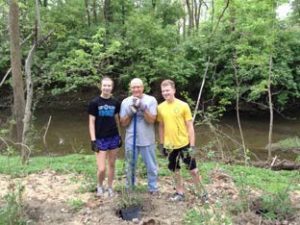2014 Wyoming, Ohio, USA

The Mill Creek is in the southwest corner of Ohio and empties into the Ohio River. It flows 28.4 miles through three different counties and about half a million people live within the watershed. It is mainly urban and industrial with some forested and agricultural lands located in the northern section. The Mill Creek also has many CSOs (combined sewer overflows) and SSOs (sanitary sewer overflows).
Thermal pollution is a problem in many of our urban streams, especially in the Mill Creek, that often flies under the radar. While thermal pollution doesn’t involve dumping massive amounts of chemicals into the rivers or many other signs that people generally associate with pollution, the heating and cooling of natural waterways (whether directly or indirectly caused by people) can have a bigger effect on wildlife ecosystems than people think.
Benny and Isabelle felt that they could do their part to reduce thermal pollution when it happens in a localized setting, such as when water temperature of creeks and streams rises due to lack of shading and foliage. Their solution was to plant trees along the banks of the North Branch of the Mill Creek. They felt it was an easy solution to tackle the problem of thermal pollution in local streams.
Benny and Isabelle put their project into action on May 10th, 2014. They had an excellent group of volunteers of both students and community members come out and help. Together they planted about 600 trees in about 3 hours. The areas where they planted were alongside a local stretch of the North Brach of the Mill Creek that was in need of restoration. It was a great time to be social and meet new people while helping out their watershed. Over all, they thought this was a very fun and education experience for them and they were honored to be offered such a wonderful opportunity.

